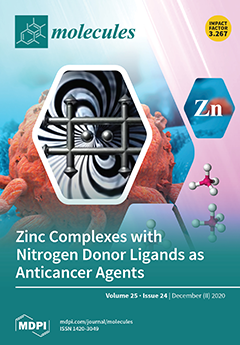The structural elucidation of primary and secondary peroxidation products, formed from complex lipids, is a challenge in lipid analysis. In the present study, rare minor oxidized cerebrosides, isolated from the extract of a far eastern deep-sea glass sponge,
Aulosaccus sp., were analyzed as
[...] Read more.
The structural elucidation of primary and secondary peroxidation products, formed from complex lipids, is a challenge in lipid analysis. In the present study, rare minor oxidized cerebrosides, isolated from the extract of a far eastern deep-sea glass sponge,
Aulosaccus sp., were analyzed as constituents of a multi-component RP-HPLC (high-performance liquid chromatography on reversed-phase column) fraction using NMR (nuclear magnetic resonance) spectroscopy, mass spectrometry, GC (gas chromatography), and chemical transformations (including hydrogenation or derivatization with dimethyl disulfide before hydrolysis). Eighteen previously unknown β-D-glucopyranosyl-(1→1)-ceramides (
1a–
a//,
1b–
b//,
2a–
a//,
2b–
b//,
3c–
c//,
3d–
d//) were shown to contain phytosphingosine-type backbones (2
S,3
S,4
R,11
Z)-2-aminoeicos-11-ene-1,3,4-triol (in
1), (2
S,3
S,4
R,13
Z)-2-aminoeicos-13-ene-1,3,4-triol (in
2), and (13
S*,14
R*)-2-amino-13,14-methylene-eicosane-1,3,4-triol (in
3). These backbones were
N-acylated with straight-chain monoenoic (2
R)-2-hydroxy acids that had allylic hydroperoxy/hydroxy/keto groups on C-17
/ in the 15
/E-23:1 chain (
a–
a//), C-16
/ in the 17
/E-23:1 (
b–
b//) and 14
/E-22:1 (
c–
c//) chains, and C-15
/ in the 16
/E-22:1 chain (
d–
d//). Utilizing complementary instrumental and chemical methods allowed for the first detailed structural analysis of a complex mixture of glycosphingolipids, containing allylically oxygenated monoenoic acyl chains.
Full article






